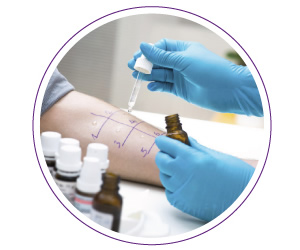
The VEGA test, DRIA test, CITO test , Iris test or Hair test: do these names that tell you something? You will have probably heard about it or, if you are an allergy sufferer, perhaps you will also have been put through one of these!
In fact, those mentioned above are widespread and fashionable allergy tests, recommended by several doctors, mainly by naturopaths and osteopaths, but not officially recognized by the scientific community because of their unreliability.
Each year, about 4 million fake exams are taken in Italy to discover food allergies and intolerances that are wasting over 300 million euros a year.

Allergy or intolerance?
Most often the term food allergy is used generically to refer to any unpleasant reaction linked to the assumption of food. In fact, we can talk about food allergy only when the body has an abnormal and excessive reaction, producing antibodies against substances that contain certain food. When the immune system is not involved it is more properly to talk about food intolerance. Generally, food allergy remains for many years, often for life, even if the offending food is avoided scrupulously. Food intolerance disappears if the food is not taken, but may recur if the food is consumed regularly.
Some numbers
The experts of the Italian allergy Society, Asthma and Clinical Immunology (SIAAIC), argue that too many Italians (about 20 millions) spend hundreds of euro in unlikely non-validated tests with the criteria of evidence-based medicine. True allergics are more than 2 million and the lactose, nickel intolerant or other substances in food are about 10 million, but it is estimated that at least other 8 million Italians, ascribe any of their discomfort to some food ,only for a psychological conditioning and pure awesomeness.
Which one of these should we avoid?
Many people fall into error because they rely on fake diagnostic tests, often known through word of mouth. The SIAAIC has banned 6 of them:
- • The hair test, which evaluates abnormalities in mineral metabolism simply by reviewing the substances present in hair;
- • The tests on blood cells, which evaluates changes suffered by white blood cells making the plasma in contact with "suspected" food extracts;
- • The strength test, which assesses changes in the strength when handling alleged harmful foods;
- • The VEGA test, which would evaluate energy imbalances caused by the incriminated food;
- • Bioresonance, which would assess the changes in the person’s magnetic field generated by the food;
- • The pulse test or the reflex cardiac headset test, which evaluates changes in pulse rate in contact with the food that might generate intolerance or allergy;

Why are these tests highly sought and practiced?
First of all, because it is a matter of little or not invasive procedure and therefore, attractive for many patients; or because of their immediate diagnosis; finally, because supported by diet management models, sometimes, real rituals that promise to overcome the allergy in a few months. The fact that these tests are carried out on complex food rather than individual substances is another very serious problem. It makes no sense to say that a person is intolerant, for example, to pasta, since pasta contains several composed substances. The intolerance can manifest itself against a molecule or a group of molecules, but never in relation to a specific food. The substances contained in food are thousands and there is currently no test that includes more than a few hundred.
The question arises spontaneously: how can we figure out if we are really allergic?
A simple food diary, for example, is a first and very useful step to be able to associate the consumption of a food to a possible reaction; then, you must contact an allergist avoiding doing it yourself. The vademecum drawned by SIAAIC dedicated to patients can be very useful, a true "guide" to recognize the symptoms of a possible allergy and how to behave.
THE HANDBOOK FOR
WHOM SUFFERS FROM FOOD ALLERGY
WHEN SHOULD FOOD ALLERGY BE SUSPECTED? Anytime a certain food is eaten and characteristic symptoms appear.
WHO SHOULD BE CONTACTED? A doctor expert in allergies who is a specialist in the field (pay attention to those who praise skills not certified).
WHAT TO EXPECT: people are born allergic, thus, the food is initially tolerated. Since the first reactions, the consequential relationship between food and symptoms will be inevitable in the following years.
WHAT SHOULD BE DONE WHEN FOOD ALLERGY IS SUSPECTED? First, a diary in which all the ingested food and any appeared symptoms daily registered, must be kept.
- AT THE ALLERGY EXPERT'S?
- • An etiological diagnosis, throughout a reliable allergy test, is the identification of the food which cause certain reactions;
- • A proper diet from a nutritional point of view;
- • Behavioral and lifestyle tips, for example, in specific cases, physical activity in 2 or 4 hours before and after the meals should be avoided;
- • Prescriptions for therapeutic emergency and instructions for their usage;
- HOW SHOULD VIRTUOUS PATIENTS BEHAVE THEMSELVES?
- • They must adopt a dietary regimen;
- • Read the labels and pay attention to hidden allergens!!!
- • Do not underestimate sentinel symptoms of serious adverse reactions (itching on the palms of hands and soles of the feet, angioedema, change in tone of voice, etc..);
- • Have available drugs for medical emergency if required.
- • Make periodic checkups at a specialist, not only in case of new clinical developments!
- • Inform parents, relatives and friends of their allergy, anyone who can help in case of need;
- • Declare the allergy when eating in a restaurant or in places of public or private catering requesting a paper in which all the ingredients used are shown.
